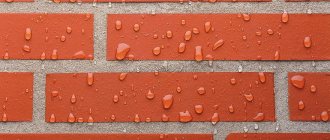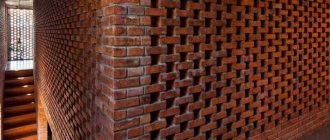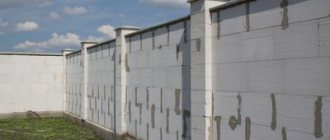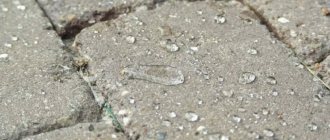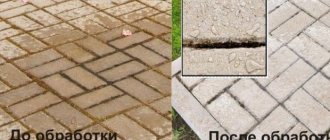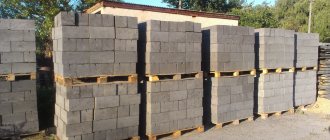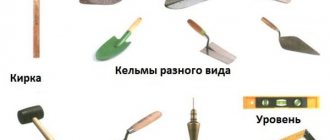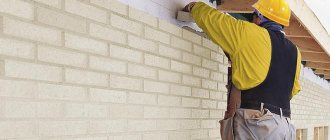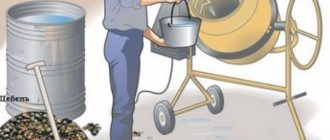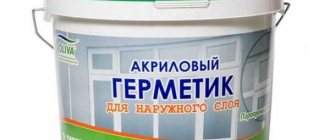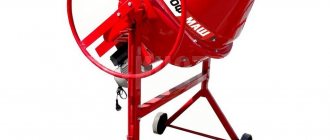Water is life on Earth. It nourishes the soil, giving life to plants. Thanks to the capillary effect, moisture rises to the topmost leaf of the tallest tree and penetrates into the very depths of brick and concrete. Gives life and destroys matter. Nature has learned to defend itself by dropping leaves and stopping the flow of fluid through the “veins.” Brick, unfortunately, still gets wet in the rain and suffers all the hardships in the severe frost.
Let's protect our favorite brick from water and mold! And for this, it will delight us for many (very long) years with its beautiful appearance and constant strength.
General information about water repellents
A water repellent is a solution that gives the surface being treated low adhesive properties with water molecules (blocks the capillary effect). Let me explain.
Wood, concrete, brick, stone are porous building materials. When water gets inside, it saturates the surface and goes deep into the substance. When freezing occurs, the H2O crystal lattice expands and, as a result, gradual destruction occurs.
Hydrophobic solutions “lined” the treated surface with a thickness of one microparticle, preventing wetting (the well-known “Teflon”). Water molecules collect in drops and, under the influence of gravity, roll down from a vertical plane.
There are 2 ways to combat capillary phenomena in construction:
- Protect the surfaces of concrete, brick and wooden buildings from moisture with other materials (insulation, vapor and waterproofing insulators).
- Treat with a special penetrating compound - a water repellent.
Materials used
Hydrophobization of the facade can be carried out using various types of impregnating compositions, the most effective of which are materials made on the basis of silicone or silicon. Such compositions well protect the walls of the building from moisture, without disturbing the natural air exchange through the facade of the building. Known silicone water repellents can be made in the form of:
- water emulsions;
- organosoluble compounds;
- water-soluble mixtures.
Just like compositions based on silicon compounds, silicone water repellents do not lose their performance properties for quite a long time. When processed, they penetrate into the thickness of the walls to a depth of about 15 mm, as a result of which a polymer film layer is formed on their surface, creating an impenetrable barrier to moisture. At the same time, the moisture absorption coefficient of the material decreases several times (for brick, in particular, this figure can reach 20 times).
Currently, manufacturers of water repellents offer a wide selection of colorless and tinted impregnations, some of which allow one to obtain various effects (the effect of “wet” bricks in particular). In addition, such impregnations may also contain other protective compounds (antiseptics or fire retardants, for example).
The need to use water repellents for bricks
Brick is an environmentally friendly, breathable, durable, beautiful building material. “Breathing” is provided by the number of pores in the body. When they get wet, they fill with water. Moisture frozen in the pores slowly but surely destroys the stones.
The water repellent does not fill the pores, but forms a thin film on the surface of the substances, preventing them from filling with water. That is why such a property of brick as vapor permeability is preserved.
To assess the seriousness of the harmful effects of water, Table No. 1 shows such characteristics of building materials as water absorption. And the higher it is, the lower the strength of the product.
Table No. 1. Water absorption of building materials by weight, %
| Ceramic brick: | private | 12..16 |
| facial | 8..10 | |
| Silicate brick: | private | 6..16 |
| facial | 6..14 | |
| Clinker brick | 3..5 | |
| Tree | 23..30 | |
| Concrete | 4..8 | |
| Aerated concrete | 25 | |
| Foam concrete | 10..16 | |
Why is processing needed?
The weakest point in the masonry is the seams. It is through them that moisture penetrates inside, and during frosts the water freezes. There it expands and impacts the bricks, causing the material to collapse. Also, some types of brick can absorb moisture through the pores, which does not have time to dry and remains inside, resulting in microcracks and chips, which also leads to destruction. To protect bricks from corrosion, experts recommend treating them with special compounds and carrying out hydrophobization.
Rules of use and first water repellents
Hydrophobization technology was first used in the 60s of the last century. The composition of water repellents was organosilicon and did not meet fire safety requirements. They needed to be applied frequently. In this regard, they have not found widespread use.
Science does not stand still. The modern selection of hydrophobic compounds meets safety requirements and is increasingly used in construction. The advantage of hydrophobic solutions is their ability to give building materials frost resistance, resistance to fungi, dust deposition, and a presentable appearance for many years.
Surface hydrophobic agents are applied to a dry or damp surface (read instructions). It is best to carry out work in the spring and summer, because... a certain air temperature is required. The old facing surface must be restored, cleaned of fungus and treated with a fungicidal composition. It is advisable to apply some solutions in 2-3 layers.
Many formulations are sold in concentrated form. They are diluted, mixed thoroughly and the surface is covered with a roller, brush or spray.
As a rule, the liquid is colorless (we want the natural look of brickwork). And most importantly: after treating the surface, not a single paint will “stick” to the facade. Hydrophobization is the final stage of finishing work.
Hydrophobization of facades by industrial climbers
To carry out waterproofing of multi-storey buildings, it is advisable to use the services of industrial climbers. This will avoid the need to install scaffolding and use other complex lifting devices. Climbers have access to the most difficult places to climb. Professional companies will correctly assess the condition of the walls and select a suitable water repellent. The cost of services of industrial climbers is from 300 rubles. per sq. m. excluding the price of materials. The price for waterproofing facades depends on the following factors:
- complexity;
- volume;
- architectural features of the building;
- wall material.
The final cost of waterproofing facades by climbers will depend on the selected product.
Modern water repellents and technology for their application
There is a huge selection of compounds, impregnations, and mastics on the market. To figure out which water repellent is good and which is better suited for protecting brick or stone masonry, let’s look at their composition according to table No. 2.
Table No. 2. Classification of water repellents by composition
| Composition of hydrophobic impregnation | |||
| Alkyl siliconates | N-siloxanes | Silanesiloxanes | |
| Potash | Sodium | ||
| Water-based, soluble in water. They are often added at the production stage of building materials. Follow the recipe, otherwise there may be efflorescence. | Improved modification. Not for limestone. Does not change the color of the base. The water repellent is suitable for silicate and ceramic bricks. | The best water-repellent properties. Deep penetration. Long-lasting water repellent. A “wet stone” effect is possible. | |
| Low price. Low efficiency. Partially block the pores. Mainly for volumetric hydrophobization. | The price is lower than that of potash. They swell with water. It is highly undesirable to use it! | ||
Basic rules for applying a hydrophobic solution to brickwork in compliance with safety precautions:
- clean the surface from dust, dirt, old paint, efflorescence;
- eliminate façade defects;
- dilute the composition in accordance with the instructions;
- Apply the solution with a roller, brush, or spray.
Depending on the porosity of the material, the water repellent penetrates 2-20 mm deep.
Application method or construction plan
Preparatory stage
Before impregnating brick walls, it is recommended to prepare the surface so that the solution is better absorbed and the coloring is uniform. Any walls, whether underground or outdoors, should be cleaned of dirt, debris, grease or ash. Degreasers and a nylon brush will be useful here. You need to rinse the surface with water and wait until the water dries completely.
Application stage
You can cover the walls in any convenient way: roller, brush or spray. You can impregnate each brick separately, using a brush, which should be equal in width to the building material. If you don’t have a lot of time, you can use a sprayer or a roller, which will provide less precision and will only cover the brick, but not the mortar. It is recommended to brush the brush once along the length of the stone and back. It is better not to apply a lot of impregnation and make sure that there are no drips. Surface treatment is permitted only with protective rubber gloves and special goggles. If for any reason penetrating masonry waterproofing gets into your eyes, it should be washed off with water.
Main types of water repellents
There are three main types of hydrophobic compounds: surface, bulk and cut-off.
The surface hydrophobic solution is applied with a roller or brush. The liquid is colorless and absorbs quickly. After an hour, reapply. As a result, the facade is protected from moisture, frost, and graffiti.
Volumetric hydrophobization is carried out at the production stage of the building material. For example, for bricks, when making a mortar, a water repellent is mixed into the water.
Combining these two types gives maximum effect.
Cut-off hydrophobization is used to enhance the waterproofing of the foundation by injection.
Siloxyl . Water-based organosilicon compounds (silicones). Slightly toxic and non-flammable. It is odorless and colorless.
Aquasil . A new generation of domestic organosilicon compounds based on soda in aqueous solution. Available in the form of a concentrated composition. Designed for surface, volumetric and cut-off protection. Service life more than 10 years.
The hydraulic shield is super . Composition of water-based organosilicon polymers for environments with high humidity. Has antiseptic additives.
GSK-1 . Universal water-based impregnation with antiseptic properties for use both outdoors and indoors. Used for plaster, brick, concrete, wood, aerated concrete, etc. Available in two versions: regular and frost-resistant.
GSK-2 . Gasoline-based impregnation. The composite is intended for use in more severe conditions. It is an excellent material for applying cut-off hydrophobization. When applied it is toxic and flammable! After drying it is safe and has a hygienic certificate. It is also used for fabrics.
Ceresit (tsirezit) ST 13 . Aqueous dispersion of silicones. Products of the German company Henkel. They process vertical surfaces of concrete, ceramic, sand-lime and clinker bricks, plaster, facing stone, roofing tiles, etc. Service life 8-12 years.
Deumical . Surface impregnation with deep penetration to combat efflorescence and fungi on brickwork (contains solvents). Suitable for both external and internal processing. The manufacturer is the Italian company Index SpA
Which façade needs hydrophobization?
The facade is in contact with the environment every second, which has a detrimental effect on it. Modern developments in the field of protection of building materials make it possible to minimize the influence of moisture and ultraviolet radiation. When constructing new houses, this opportunity is taken into account and implemented. But in addition to new buildings, there are a huge number of buildings that have been in use for a long time.
Hydrophobization is a relatively new concept that not every owner of a private home knows about.
Therefore, it is important to familiarize yourself with the list of signs, the presence of which will help you understand whether the structure needs additional protection
Sign No. 1. Presence of efflorescence
Due to the porous structure, molecules of water and various salts that make up its composition circulate inside any building material. This is an inevitable process due to the nature of substances. At a positive ambient temperature, water molecules rush to the surface of the facade and evaporate (evaporation process). The salts associated with them remain on the material in the form of a whitish precipitate. These are efflorescences.
They are formed all year round, since salt solutions do not freeze. But during the cold period of the year, the intensity of efflorescence noticeably decreases. In winter, the evaporation process is slowed down, and salts crystallize inside the material, destroying its structure. As a result, the estimated service life of the facade is reduced.
Sign No. 2. Presence of wet and muddy spots
Foam concrete and aerated concrete are classified as highly hygroscopic materials. Drops of water and spots of dampness can often be seen on the surface of these building stones. Dirt and dust circulating in the air settle on the damp surface of the facade, significantly reducing its aesthetic appeal. This applies not only to foam and aerated concrete, but also to brick, concrete, natural or artificial stone.
The climate of the region is of great importance. If air humidity is increased, the process of destruction of materials is more intense. Therefore, for areas with a maritime climate, the construction of buildings from porous and hygroscopic materials is not recommended.
Sign 3. Presence of fungus and mold
The presence of pathogenic microflora indicates an increased level of moisture in the building material with all the ensuing consequences: destruction and premature aging.
Sign 4. Drops of water protruding on the surface of the facade
Considering the above, we can conclude that it is reasonable to take care in advance to protect the facade and prevent the appearance of signs of erosion and other negative processes. For this purpose, a complex of chemical and organic based products has been developed. And the process of applying them is called “hydrophobization”. There is no doubt about its necessity.
Before you begin restoration, assess the situation
What you will need: tape measure, small ruler, level, plumb line, feeler gauge.
Before starting work on the restoration of brickwork, it is necessary to assess its technical condition. The research can be divided into three stages.
Superficial inspection
Visual assessment allows you to detect:
- cracks on the surface of the brickwork,
- destruction (looseness, spalling, chips, potholes) and/or lack of individual bricks,
- weathering of seams,
- separation of masonry rows,
- rust spots and efflorescence on the surface,
- fungus, mold, moss.
Rust on the surface of the masonry is a sign of loss of structural integrity due to corrosion of steel embedded parts or reinforcement.
Measurements
To clarify the data obtained during a visual inspection and assess the extent of damage, it is necessary to measure:
- thickness and depth of cracks,
- seam thickness,
- angles of deviation of the masonry from the vertical and horizontal in the plane of the wall (at the seams),
- angles of deviation of the masonry from the plane of the wall.
Before restoring the brickwork, it is necessary to eliminate the root causes of deformation, otherwise repeated destruction cannot be avoided.
>Control of deformation development
If cracks appear in the masonry, it is necessary to monitor the dynamics of destruction. To do this you need:
measure the initial width and depth of the crack, mark the measurement location by installing beacons (made of paper or plaster); monitor dynamics at regular intervals; eliminate the root cause of deformation, which most often consists of subsidence of the soil, foundation or part of the building; make sure that the condition of the cracks has stabilized.
Composition analysis
If there is efflorescence on the masonry, it is also recommended to conduct a laboratory study of its chemical composition. It allows you to find out the amount of sulfates, nitrates, salts and moisture contained in the masonry.
Material for analysis is taken from four points distant from each other.
Cases when masonry is considered emergency
Bricks or masonry blocks overhang and threaten to fall. The masonry is deviated from the vertical by more than 1/200 of the wall height or 1/3 of the masonry thickness. The masonry bulges (sticks out from the plane of the wall) by more than 1/200 of the height of the deformed area or 1/3 of the thickness of the masonry. Cracks cross four or more courses of masonry. Damage to the masonry is more than 2 cm deep. Disorder or delamination of the masonry rows is observed.
Coating features
The principle of working with varnishes is similar to painting. First of all, you need to prepare the surface to be treated. The walls must be cleaned of dirt and dust, cracks filled with putty, growths cut down, and recesses filled with plaster or putty. If the facade was previously painted, the paint should be completely removed.
Leveled walls must be sanded with coarse sandpaper and then washed. A household detergent will work for this. After drying, a re-inspection is carried out. Identified deficiencies are eliminated. A dry, clean surface is primed. It is advisable to use primer and varnish from the same manufacturer.
Application is carried out in several ways: brush, roller or spray. In the latter case, the mixture (if it is not in an aerosol can) must be mixed with a solvent to reduce the density. If this is not done, the spray gun will not cope with heavy varnish.
Varnishing begins from one of the upper corners, gradually moving down. On large areas it is convenient to work with a 20 mm long pile roller. Small elements are treated with a brush with natural hard bristles. Adjacent strokes should be applied with an overlap of several millimeters. The varnish is applied in two layers or more. Each subsequent layer is applied after the previous one has completely dried (absorbed).
Caring for the varnish coating consists of treating it with a mild detergent twice a year.
See below for more details.
Calculation of the amount of primer
Quantitative calculation of the primer composition is a material indicator as part of the costs of finishing work. There are no uniform reference standards, since when determining consumption it is necessary to take into account the condition of the surface, the number of layers of application of the composition, and the type of finishing material.
The average figures per 1 square meter in one layer are indicated by the manufacturer and they are approximately as follows:
- acrylic primer – 130 -150 g/m2;
- water-dispersed soil – 100 g/m2;
- deep penetration soils – 180 g/m2.
When calculating, it would be correct to increase the total amount of composition by 10%. This is explained by the fact that there may be corners and protrusions on the surface that have to be primed with a slight excess of material.
So, when calculating the amount of soil, you need to: measure the surface area, multiply this figure by the average consumption, then multiply by the number of layers and add 10% of the resulting value. This will determine the total amount of primer.
